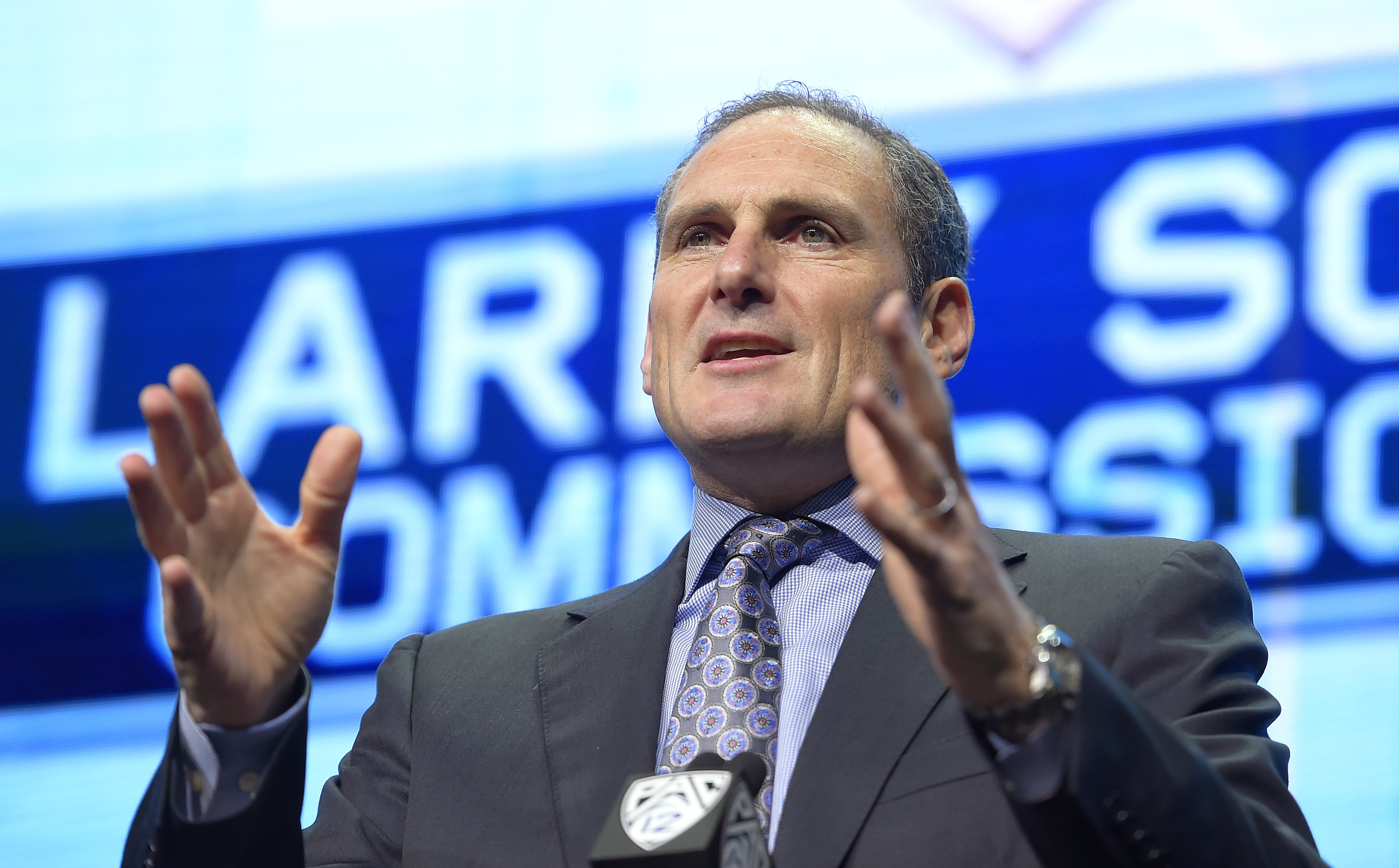He’s going to hit 50, after all.
Fifty million.
Fifty million dollars.
When the final check clears, former Pac-12 commissioner Larry Scott will have collected $50 million from the conference over the length of a tenure that was second-rate at best and an abject failure at worst.
In fact, Scott might already have the final dollar in hand.
On Friday, the Pac-12 released its federal tax filings for the 2022 fiscal year. The document indicates Scott was paid $4.1 million for his final six months on the job, from January through June of 2021.
That whopping total included a $1.5 million severance payment.
Oh, but there’s more. According to the conference, the final installment of Scott’s compensation will appear on the tax filings released next spring, for the 2023 fiscal year, based on the separation agreement he reached with the Pac-12’s board of directors (i.e., the university presidents).
Assuming the $1.5 million appearing on the 2022 filings represented half of Scott’s severance package — and the board wanted to spread the payments out over two years — the other half will push him over the $50 million mark in total compensation from the Pac-12 over his 13 years under contract.
How do we know this?
The Hotline examined Scott’s compensation in the Pac-12’s financial reports for every year dating back to 2013 and used figures reported by USA Today for the payment periods from 2009, when Scott was hired, through 2012.
Those records indicate he has taken home just short of $49 million in base salary, bonuses and severance.
His annual compensation started at $1.9 million.
By Year Three, he was clearing $3 million.
By Year Five, he was over $4 million.
By Year Nine, he hit $5 million.
(He would already have zoomed past $50 million without the pandemic, which forced the conference to cut salaries and initiate layoffs and furloughs.)
Add the remaining severance payment (presumably $1.5 million) that should become public next spring, and Scott should finish with about $50.5 million in total pay.
Coincidentally, the Pac-12 Networks are on the hook for receiving at least $50 million in overpayments from Comcast resulting from a management fiasco on Scott’s watch.
He was, after all, the chief executive of the networks and the commissioner of the conference. That dual role, unprecedented in college sports, was the purported basis for his massive annual compensation.
And who’s paying for that mismanagement? The campuses, of course. Comcast is expected to withhold that amount from current and/or future distributions to the Pac-12, leaving athletic departments with a considerable hole in their budgets.
But let’s not blame Scott for the egregious sum collected over the course of 13 years. Nope. Nobody would turn down that cash if offered. He’s no fool.
Instead, fault lies entirely with his bosses, the university presidents. They negotiated his contract, installed him as chief executive of a media company, signed him to multiple extensions, allowed the Pac-12 Networks to operate without the proper checks and balances, then handed him that glorious severance package.
Only two presidents remain from the original group that hired Scott in 2009, Arizona State’s Michael Crow and UCLA’s Gene Block. They bear the greatest responsibility, by far, but there are others — particularly the gang of 12 that could have cut Scott loose in the spring of 2018. Instead, they signed him to an extension through 2022.
Imagine the damage (financial damage, strategic damage, brand damage) that can be traced to those fateful final four years.
And imagine the state of the Pac-12 right now if Scott had been cleared out.
Would USC and UCLA have fled the conference? Probably not, because a different commissioner would have accepted ESPN’s reported offer to take over the Pac-12 Networks in exchange for a lengthy media rights agreement — an agreement that would have sealed off the escape hatch when the Big Ten developed a taste for expansion.
But Scott rejected the deal and convinced the presidents that his brainchild (the networks) eventually would lead to a jackpot when the distribution contracts expired in 2024.
That jackpot proved to be a mirage, leaving the conference to fight for survival with a crater in its core and a wholly-owned media company that never came close to matching revenue and distribution promises.
All of which is to say: The presidents have botched this in every meaningful way over the years, from Scott’s compensation to the basketball games in China to the Pac-12 Networks strategy on down the list.
And always, the athletic departments are left paying the price and bearing the burden.
Yes, sure, the presidents are highly intelligent administrators running billion-dollar operations and, in many cases, have executed adroitly for their universities.
But athletics matter, and football, especially, matters.
When was the last time 50,000 people gathered on campus for a political science lecture?
Winning football leads to enhanced alumni engagement and increased donations across all facets of campus.
It leads to better name recognition for the school, which sparks more applications for enrollment from out-of-state (full cost) students.
That leads to greater selectivity in admissions, which boosts academic rankings and reputation, which attract a stronger candidate pool for faculty positions.
Football can be part of a virtuous circle for the university.
But it must be done right at both the campus and conference levels, especially with regard to big-ticket items and major strategic decisions.
To that end, the presidents who ran the Pac-12 during the Scott era failed in their duties, fiduciary and otherwise.
Related posts:

(AP Photo/Ashley Landis)
Pac-12 Hoop Power Rankings – Oregon in Position for Tournament Bid Kliavkoff says Big 12 “scared,” UCLA in tough spot with Big Ten move, Pac-12 exploring expansion and big tech interested in media rights
Kliavkoff says Big 12 “scared,” UCLA in tough spot with Big Ten move, Pac-12 exploring expansion and big tech interested in media rights
 Hotline mailbag: Kliavkoff’s grant-of-rights challenge, UCLA’s fate, Big 12 fans, streaming options, SDSU’s position and more
Hotline mailbag: Kliavkoff’s grant-of-rights challenge, UCLA’s fate, Big 12 fans, streaming options, SDSU’s position and more
 Business of Sports – Former Fox Sports president skeptical that Big Ten move would make sense for Washington, Oregon, Bay Area schools
Business of Sports – Former Fox Sports president skeptical that Big Ten move would make sense for Washington, Oregon, Bay Area schools
Jon Wilner
Jon Wilner has been covering college sports for decades and is an AP top-25 football and basketball voter as well as a Heisman Trophy voter. He was named Beat Writer of the Year in 2013 by the Football Writers Association of America for his coverage of the Pac-12, won first place for feature writing in 2016 in the Associated Press Sports Editors writing contest and is a five-time APSE honoree.
